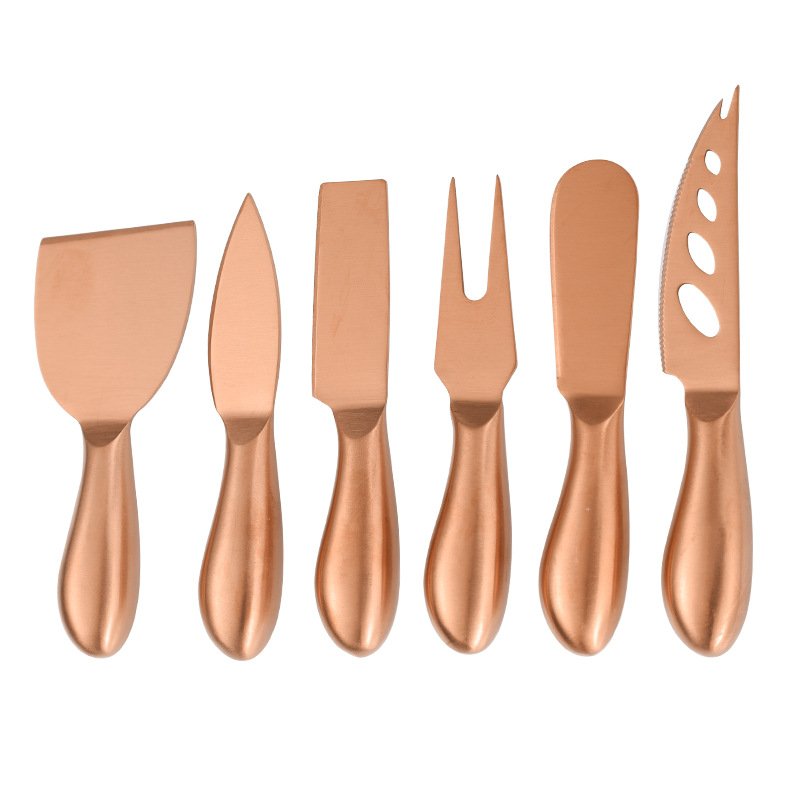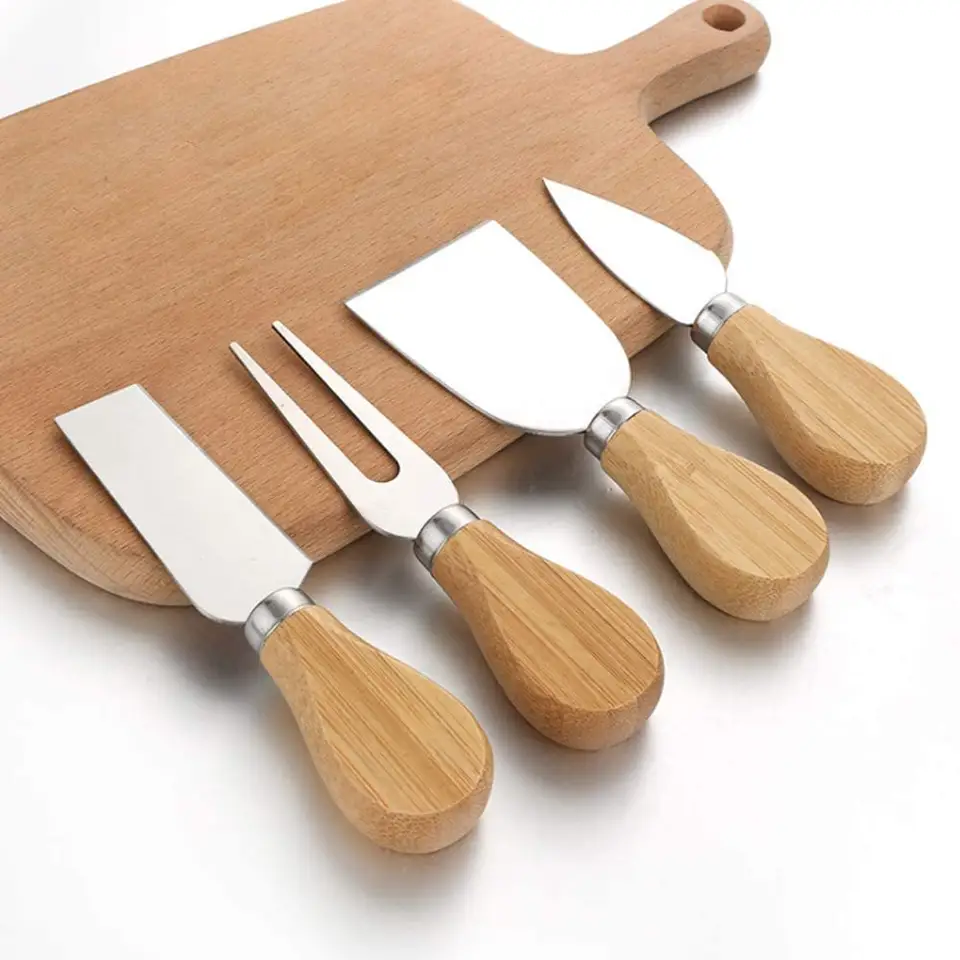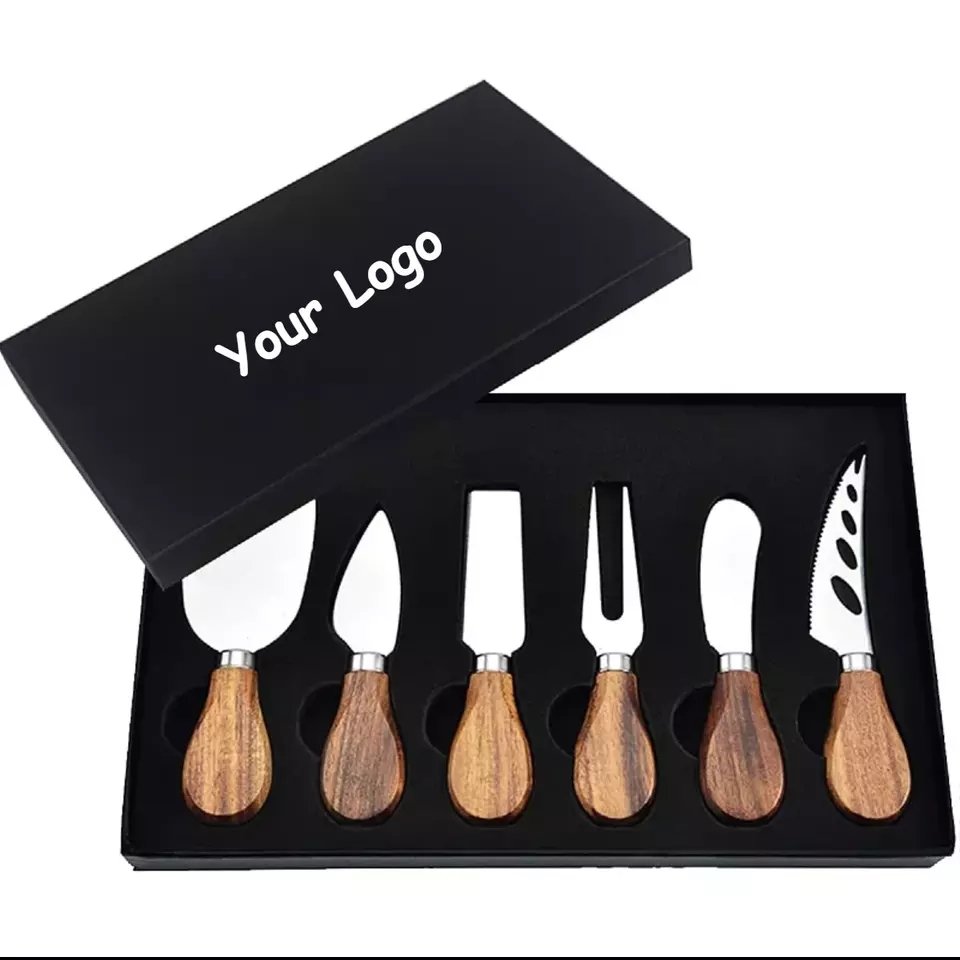When you shop for cutlery, the number of brands can be overwhelming. But, how do you know if there’s a real difference in quality between them?
Yes, cutlery brands differ in quality based on factors like material, craftsmanship, and design. Understanding these differences can help you make the right choice for your needs.
As a supplier of high-quality cutlery, let me walk you through the essential factors to consider when choosing between different brands, and how you can recognize quality cutlery.
Table of Contents
How can you tell if cutlery is good quality?
With so many options, it can be hard to spot high-quality cutlery. But there are specific traits you can look for to help you identify top-tier products.
Quality cutlery is determined by the material, construction, and finishing. Key indicators include weight, balance, and resistance to rust or corrosion.
To truly assess cutlery quality, we need to look beyond just appearance. Here’s how to identify the quality of a piece.
Material Quality: Stainless Steel Grades
The most common material for cutlery is stainless steel, but not all grades are equal. The higher the grade, the better the resistance to rust, tarnishing, and staining.
| Material Type | Chromium % | Nickel % | Key Features | Best Use Cases |
|---|---|---|---|---|
| 18/10 Stainless Steel | 18% | 10% | Excellent rust resistance, shiny finish, premium standard | High-end hotels, gift sets |
| 18/8 Stainless Steel | 18% | 8% | Slightly less nickel, still good quality for daily use | Home dining, restaurants |
| 18/0 Stainless Steel | 18% | 0% | No nickel, lower cost, more prone to corrosion, duller look | Budget-sensitive buyers |

Craftsmanship: Weight and Balance
High-quality cutlery should feel substantial but not overly heavy. A well-balanced knife or fork will feel comfortable in your hand, and the weight distribution will be even.
Finish: Polished and Smooth
Check for smooth, even polishing. Poor quality cutlery often has rough spots or tarnishing, indicating inferior finishing processes.
| Material Grade | Chromium | Nickel | Durability | Rust Resistance |
|---|---|---|---|---|
| 18/10 Stainless | 18% | 10% | Excellent | Very High |
| 18/8 Stainless | 18% | 8% | Good | High |
| 18/0 Stainless | 18% | 0% | Fair | Medium |
What is the highest quality cutlery?
If you’re after the best of the best, which cutlery should you choose? Let’s explore the top options available in the market.
The highest quality cutlery is typically crafted from 18/10 stainless steel, known for its durability, rust resistance, and beautiful finish.
When considering the highest quality cutlery, it’s important to look at both the materials used and the brand’s reputation.
Stainless Steel Grades: Why 18/10 is the Best
18/10 stainless steel is the top choice for premium cutlery. The higher nickel content offers better resistance to tarnishing, which is why this grade is often seen in fine dining cutlery sets.
– Brands to Consider: High-end brands such as Wüsthof, Victorinox, and Laguiole are known for their top-tier craftsmanship, using 18/10 stainless steel for their cutlery lines.
Craftsmanship and Functionality
A major factor in cutlery quality is craftsmanship. The best brands employ advanced manufacturing techniques, ensuring the blades are sharp, the utensils are ergonomically designed, and every piece is durable.
| Brand | Material Used | Durability | Typical Price Range |
|---|---|---|---|
| Wüsthof | 18/10 Stainless Steel | Very High | $$$$ (Premium) |
| Victorinox | 18/10 Stainless Steel | High | $$$ (Upper Mid-range) |
| Laguiole | 18/10 Stainless Steel | High | $$$$ (Premium) |
What is the best grade of cutlery?
When shopping for cutlery, you’ll often see various grades. But what’s considered the best?
The best cutlery grade is typically 18/10 stainless steel, offering superior resistance to rust, corrosion, and tarnishing, while maintaining a high-end finish.
The grade of stainless steel used in cutlery significantly impacts its performance, durability, and appearance. Let’s break it down.
Stainless Steel Grades Explained
18/10 Stainless Steel: Combines excellent corrosion resistance with a brilliant, long-lasting shine. This is the top choice for professional kitchens and upscale dining settings.
18/8 Stainless Steel: A great mid-tier option for daily use. It offers good durability and rust resistance, though slightly less than 18/10.
18/0 Stainless Steel: The budget-friendly choice. While affordable, it lacks nickel, making it more susceptible to rust and wear over time.
| Grade | Chromium Content | Nickel Content | Rust Resistance | Ideal Use |
|---|---|---|---|---|
| 18/10 | 18% | 10% | Very High | Premium cutlery |
| 18/8 | 18% | 8% | High | Everyday dining |
| 18/0 | 18% | 0% | Medium | Budget solutions |
What is the best type of cutlery to buy?
So, which type of cutlery is the best for your needs? Whether you need cutlery for daily use or for a special occasion, the type of cutlery you choose matters.
The best cutlery depends on your preferences. Stainless steel, particularly 18/10, is the most reliable and durable material for both everyday and high-end use.
When selecting cutlery, consider your needs and the types of meals you typically prepare. Here’s a breakdown of what might work best for you.
Stainless Steel: The Top Choice
Stainless steel cutlery, especially 18/10, is ideal for most consumers due to its strength, versatility, and resistance to rust. It’s perfect for both daily meals and formal occasions.
Other Materials: Silver vs. Gold-Plated
Some people prefer silver or gold-plated cutlery for special occasions. These materials are more delicate and require more care but offer a premium aesthetic.
Versatility in Design
Opting for a versatile design that complements various dining setups can be a good investment. Simple, elegant pieces work well for any table setting.
| Material | Durability | Ideal Use | Maintenance |
|---|---|---|---|
| Stainless Steel | Very High | Everyday use | Easy to clean |
| Silver | High | Special events | High maintenance |
| Gold-Plated | High | Formal occasions, luxury dining | Requires gentle cleaning to prevent wear |
Is expensive cutlery worth it?
Is the high price tag of premium cutlery justified? Let’s explore whether the benefits of expensive cutlery outweigh the cost.
Expensive cutlery is often worth the investment due to its durability, design, and long-term performance. However, there are high-quality affordable options as well.
Expensive cutlery can be an investment, but you must assess the value it offers.
Durability and Longevity
Premium brands use superior materials and manufacturing processes, ensuring their products last for decades. This means fewer replacements over time.
Design and Craftsmanship
Higher-end cutlery often features intricate designs and better ergonomics, making them more comfortable and aesthetically pleasing.
Cost vs. Quality
While you may pay more for high-end brands, the longevity and experience often justify the price. However, there are also affordable brands that offer good quality, especially if you’re looking for a functional set rather than a luxurious one.
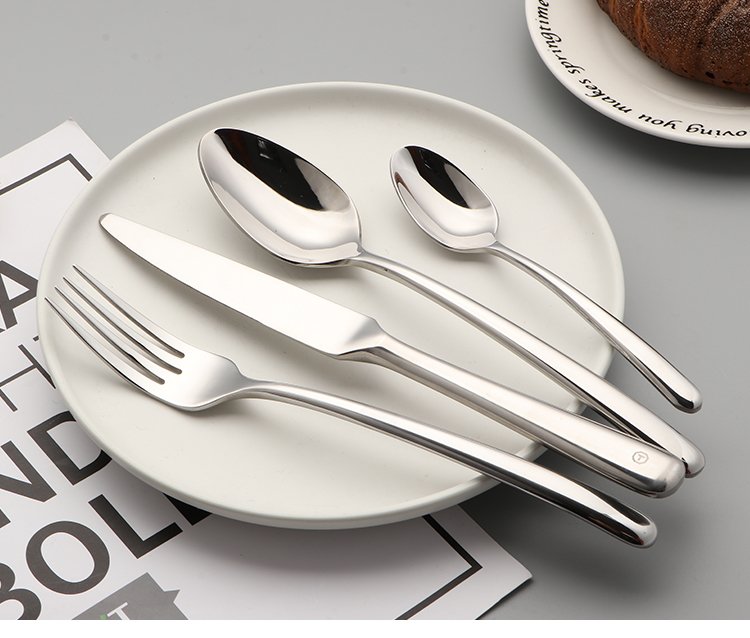
What is the difference between flatware and cutlery?
You might have heard the terms “cutlery” and “flatware” used interchangeably, but are they the same thing? Let’s clarify the difference.
Cutlery refers to utensils like knives, forks, and spoons, while flatware typically refers to spoons and forks, excluding knives.
The confusion between cutlery and flatware often arises, but understanding the distinction can help you make the right purchase.
Cutlery vs. Flatware
| Term | Definition | Common Items Included | Usage Region | Notes |
|---|---|---|---|---|
| Cutlery | Tools used for cutting and eating food | Knives, forks, spoons | UK, Asia, Global | Often includes specialty and prep tools |
| Flatware | Utensils used for eating, not necessarily cutting | Forks, spoons (sometimes knives) | North America (esp. USA) | Emphasizes table setting utensils |
Regional Terminology
In some regions, “flatware” includes knives, while in others, “cutlery” may refer to all utensils. It’s essential to clarify this when shopping, especially for formal dinner sets.
Which is better, 18/0 or 18/10 stainless steel?
Choosing between 18/0 and 18/10 stainless steel can be tricky. So, which one is better for your cutlery?
18/10 stainless steel is the better choice due to its higher nickel content, which provides better rust resistance and a more polished finish.
Let’s compare these two grades in detail to see which one fits your needs best.
18/0 Stainless Steel: A Budget-Friendly Option
18/0 stainless steel contains no nickel, making it more affordable but also less durable. It’s prone to corrosion over time and doesn’t shine as much.
18/10 Stainless Steel: The Premium Choice
The added nickel in 18/10 stainless steel makes it more resistant to rust and gives it a sleek, reflective finish. This makes it the best choice for both durability and aesthetic appeal.
| Grade | Nickel Content | Durability | Rust Resistance | Shine |
|---|---|---|---|---|
| 18/0 | 0% | Lower | Moderate | Dull |
| 18/10 | 10% | High | Very High | Shiny |
How can you tell if cutlery is silver or silver plated?
Silver cutlery can add a touch of elegance to any dining setting. But how can you tell if your cutlery is solid silver or just silver-plated?
Silver cutlery will typically have markings indicating its authenticity. Silver-plated items are often lighter and show signs of wear more quickly.
It’s essential to identify whether your cutlery is solid silver or silver-plated, as this affects its value, maintenance, and durability.
Identifying Silver-Plated Cutlery
Silver-plated cutlery is usually lighter and wears down quicker than solid silver. It’s also more prone to tarnishing. You can often find markings like “EPNS” (electroplated nickel silver) on silver-plated items.
Identifying Solid Silver Cutlery
Solid silver cutlery is heavier and retains its shine for a longer period. It’s often stamped with marks like “.925” or “Sterling.”
| Type | Weight | Durability | Tarnishing | Value |
|---|---|---|---|---|
| Silver-Plated | Light | Moderate | Prone to tarnish | Low |
| Solid Silver | Heavy | High | Slow tarnishing | High |
Is expensive cutlery worth it?
It’s tempting to go for cheaper cutlery. But when is it worth paying more for better quality?
Yes, expensive cutlery is often worth the investment. It lasts longer, performs better, and enhances the dining experience.
Let’s break down what makes expensive cutlery different and whether it’s truly worth the premium.
What Makes Expensive Cutlery Cost More?
| Factor | What to Look For | Why It Matters |
|---|---|---|
| Material Quality | 18/10 stainless steel or silver | Determines rust resistance, durability, and shine |
| Design & Craftsmanship | Ergonomic design, balanced weight, mirror polishing | Enhances comfort and the overall dining experience |
| Brand Value | Reputation, customer service, legacy | May influence long-term satisfaction and resale value |
Comparing Lifetime Cost
While cheap cutlery might save money upfront, you may need to replace it often due to rust or breakage. High-end sets often come with warranties and can last decades.
| Price Range | Material | Typical Lifespan | Maintenance | Overall Value |
|---|---|---|---|---|
| <$1 per piece | 18/0 Stainless | 1–2 years | Medium | Low (frequent replace) |
| $2–4 per piece | 18/8 Stainless | 5–8 years | Low | Medium |
| $5+ per piece | 18/10 Stainless | 10–20 years | Very Low | High |
Many of my long-term customers start with basic sets and eventually switch to higher-end lines from our catalog after realizing the savings and satisfaction over time.
What is the difference between flatware and cutlery?
Flatware and cutlery—are they the same? People often mix them up, but there’s a clear difference.
Cutlery typically refers to knives, forks, and spoons used for eating. Flatware is a broader term that includes any utensil used at the table, including serving pieces.
Understanding terminology helps you make informed purchasing decisions, especially in B2B sourcing or international markets.
Cutlery vs. Flatware
Cutlery: Primarily refers to the utensils used for cutting and eating, including knives, forks, and spoons.
Flatware: Includes all the utensils that are typically used on the table for eating, such as cutlery (knives, forks, spoons) and other serving utensils like ladles, tongs, and salad servers.
Regional Terminology Differences
In the UK, “cutlery” is commonly used. In the US and Canada, “flatware” is more popular. As a supplier, I adapt my product descriptions depending on client location to avoid confusion.
| Term | Includes | Used Commonly In |
|---|---|---|
| Cutlery | Knife, fork, spoon | UK, India, China |
| Flatware | Knife, fork, spoon, serving utensils | US, Canada |
| Silverware | Often used interchangeably with both cutlery and flatware | US |
When you browse our Brilliant product catalog, you’ll see that we use both terms in descriptions, so you can find what you need whether you’re sourcing for household retail or luxury hotel chains.
Which is better, 18 0 or 18 10 stainless steel?
If you’re comparing 18/0 and 18/10, you’re looking at two very different products. Which one should you choose?
18/10 is better than 18/0 in terms of corrosion resistance, shine, and longevity. 18/0 is more affordable, but more prone to rust.
This is a common question I get from buyers trying to balance quality with cost.
Composition Breakdown
18/10 Stainless Steel: This grade contains 18% chromium and 10% nickel, which provides excellent resistance to rust, corrosion, and staining, as well as a shiny finish. It is considered the gold standard for high-quality cutlery and flatware.
18/0 Stainless Steel: This grade contains 18% chromium but no nickel. While it is more affordable, it is more susceptible to rust and staining over time. It is commonly used for budget-friendly flatware options.
Use Cases
| Feature | 18/10 Stainless Steel | 18/0 Stainless Steel |
|---|---|---|
| Rust Resistance | Excellent | Moderate |
| Shine & Finish | Mirror-like | Matte or dull |
| Price | Higher | Lower |
| Dishwasher Safe | Yes | Yes (but less durable) |
| Magnetic | No | Yes |
18/10 Stainless Steel is typically preferred for high-end, professional use due to its superior durability, rust resistance, and aesthetic appeal, making it perfect for restaurants, hotels, and retail brands.
18/0 Stainless Steel is more cost-effective and works well for budget-conscious environments like schools or mass catering, where durability isn’t as critical.
At Brilliant, we offer both grades. Our 18/10 lines are popular in Europe, especially with clients who prioritize durability. Our 18/0 models perform well in the Middle East and Latin America where pricing is more sensitive.
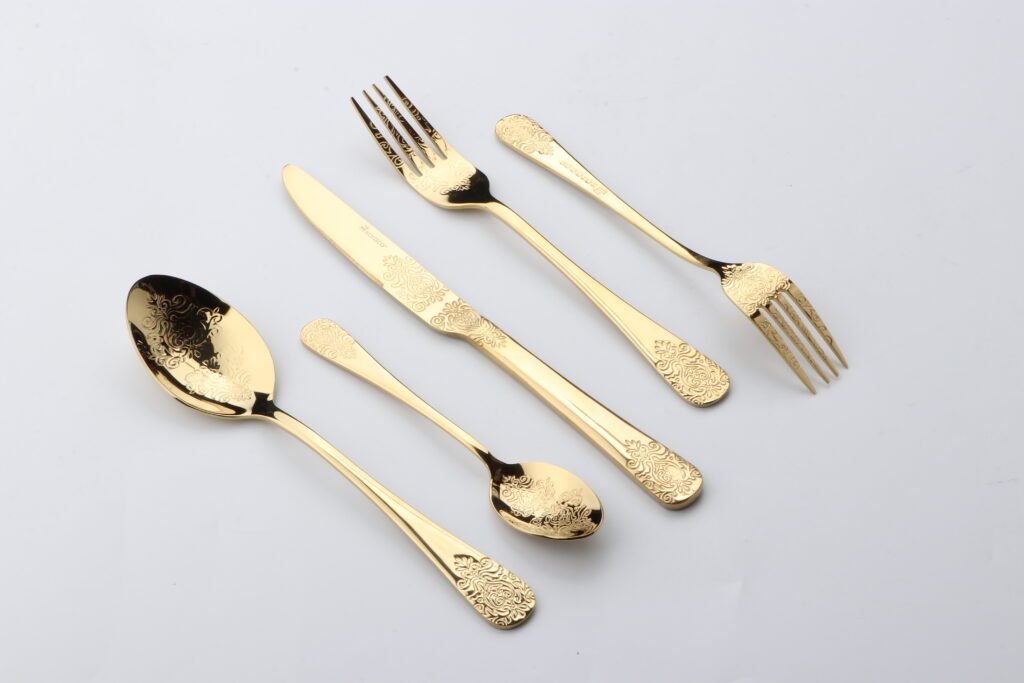
How can you tell if cutlery is silver or silver plated?
Some cutlery looks like silver, but it might be just silver-plated. How can you tell the difference?
Real silver cutlery will have hallmarks like “925” or “Sterling,” while silver-plated items often have markings like “EPNS” or no marking at all.
Being able to distinguish between silver and silver-plated is important, especially in antique markets or when sourcing luxury cutlery.
What to Look For:
Markings: Real silver will usually have a stamp.
Weight: Silver tends to be heavier.
Tarnish Pattern: Real silver tarnishes differently than plated ones.
| Marking | Meaning | Type |
|---|---|---|
| “925” | 92.5% pure silver | Sterling |
| “Sterling” | Pure silver | Sterling |
| “EPNS” | Electro Plated Nickel Silver | Plated |
| No Mark | Likely Plated | Plated |
As a factory, we focus more on stainless steel for hygiene and cost reasons. But we collaborate with workshops for clients who want silver-plated gift items.
How can you tell the quality of stainless steel?
All stainless steel is not created equal. So how do you know you’re buying the good stuff?
You can check the grade (like 18/10), test magnetism, inspect weight, and look for certifications like LFGB, FDA, or SGS.
From a supplier’s point of view, I always suggest checking a few key indicators before you trust the “stainless” label.
Grade Stamping and Certifications
Look for markings on the handle or back of the utensil. Reputable manufacturers often include the grade (18/10, 304, etc.) and sometimes even certification info.
Corrosion Resistance Testing
Salt spray tests are commonly used in our factory.
You can also do a simple lemon or vinegar test to check for reaction.
| Feature | High-Quality SS | Low-Quality SS |
|---|---|---|
| Grade Marked | Yes | Rarely |
| Magnet Test | Weak or No | Strong |
| Acid Reaction | No Tarnish | Rust Spots |
| Finish | Polished | Rough or dull |
At Brilliant, all our stainless steel undergoes SGS and LFGB testing. We’re happy to provide certificates and samples for your validation.
Which is better, 18-10 or 18 0 stainless steel flatware?
This might sound like a repeat, but when shopping for flatware specifically, this comparison comes up again and again.
18/10 flatware is better for durability and presentation. 18/0 flatware is cheaper but has lower resistance to rust and less shine.
Let’s look at this from a buyer’s standpoint, especially if you’re sourcing from Asia.
Consider the Use Environment
High-Humidity Regions: Go for 18/10 to avoid corrosion.
Short-Term Events: 18/0 might be enough if you’re on a tight budget.
Aesthetic and Branding
Your brand image matters. Shiny, durable flatware reflects well on your product or service quality.
| Attribute | 18/10 Flatware | 18/0 Flatware |
|---|---|---|
| Longevity | 10+ years | 2–5 years |
| Market Segment | Mid-to-High | Budget |
| Brand Image | Premium | Entry-Level |
| Availability | Global | Widely Available |
Brilliant offers both styles. Many of our clients start with 18/0 to test their markets, and later upgrade to 18/10 as their business grows.
What are the features of a well designed cutlery?
Design isn’t just about looks. A well-designed cutlery set should work well in the hand, not just on the table.
A well-designed cutlery set balances aesthetics, ergonomics, weight distribution, and functionality to provide comfort and elegance in use.
Design is where art meets engineering. Let’s look at what makes a truly excellent cutlery design.
Key Features of Excellent Design
Ergonomics: Should feel natural in your hand.
Weight and Balance: Proper balance between handle and head.
Finish and Detailing: Smooth edges, seamless joints.
Material Consistency: No air holes or weak points.
| Design Aspect | Why It Matters | Good Indicator |
|---|---|---|
| Handle Shape | Prevents fatigue | Slight curve, rounded edge |
| Blade/Head Size | Efficient function | Proportional to handle |
| Finish | Easy to clean and pleasant look | Mirror or satin polish |
Our design team at Brilliant works with clients worldwide to adapt classic European styles for local markets, integrating user feedback and manufacturing feasibility.
In conclusion, understanding cutlery quality comes down to knowing the materials, design, and craftsmanship. Whether you choose a high-end or budget option, selecting the right brand and grade will ensure your cutlery lasts and performs well.


